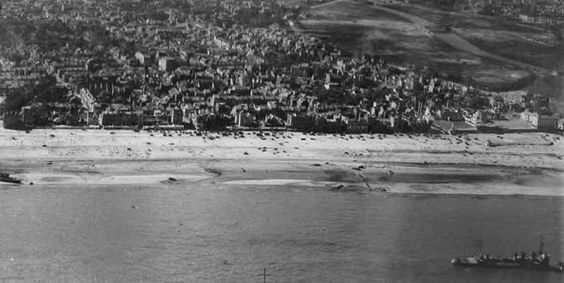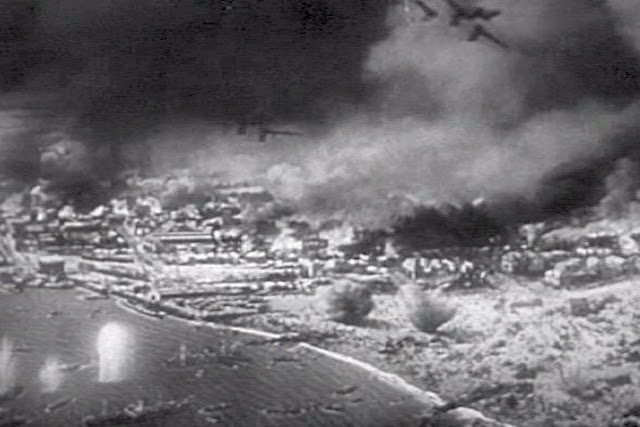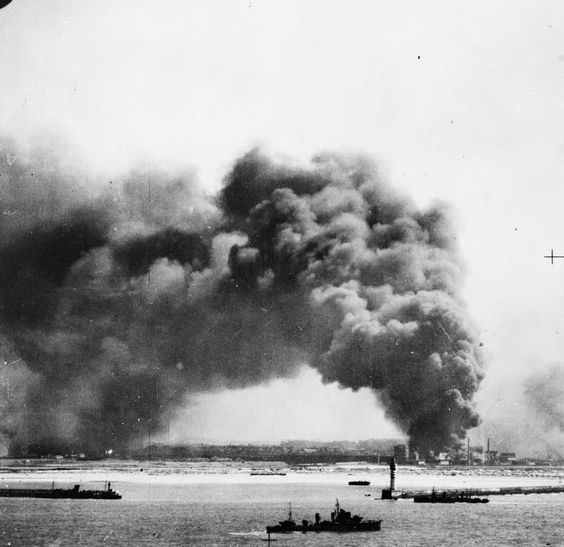Monday 3 June 1940
 |
| An RAF photograph of the Dunkirk beach taken on 3 June 1940, showing the beach littered with British equipment. |
Dunkirk: General Harold Alexander visits Dunkirk port to personally assure that the British are all evacuated. At 10:50, Royal Navy "Beachmaster" Captain William “Dunkirk Joe” Tennant signals "Operation completed; returning to Dover.”
With all the British troops out, the Admiralty decides to spend another day evacuating French and Belgian troops. All Royal Navy evacuations continue taking place at night - except for small boats. There 26,175 men taken off during the night of 3/4 June, which is about what the Admiralty has been led to believe is the total number of men remaining - but in fact, there are tens of thousands of Allied men more than that. Stragglers appear from basements and under the quays, from every which way, as the front-line troops approach the harbor. Many of the stragglers are in very poor shape, suffering from battle fatigue and PTSD.
The French defenders continue giving ground. The perimeter shrinks to about a square with each side 2 miles.
The RAF carries out 171 reconnaissance missions during the day over the beachhead, 651 bombing sorties and 2,739 fighter sorties.
The RAF also sends 142 aircraft against targets in Germany during the night.
 |
| German Stuka dive bombers attacking Allied attempt to evacuate Dunkirk, France, June 1940; still from Frank Capra's 1943 documentary film Why We Fight #3. |
U-37 (Kapitänleutnant Victor Oehrn) sinks 2,317-ton Finnish freighter Snabb about 300 miles off Cape Finisterre at 04:56. There are 20 survivors and 1 crew perishes.
Convoy OA 161G departs from Southend, Convoy OB 161 departs from Liverpool.
European Air Operations: The Luftwaffe launches Operation Paula. This is the planned destruction of the Armée de l'Air (ALA), or French Air Force. The objectives include eliminating French airfields and aircraft factories. The operation has been postponed since 30 May due to poor flying weather. The Germans use both Luftflotte (Air Fleet) 2 and Luftflotte 3. The French have some warning of this operation from intercepted Enigma transmissions.
The Germans use 640 bombers and 460 fighters in three waves. They attack 28 railways and marshaling yards, 22 train stations, and 15 factories, causing slight damage. The Luftwaffe loses 4 bombers and a total of 10 aircraft, while the French Air Force loses 20 aircraft on the ground and 15 in combat. Josef Kammhuber, Geschwaderkommodore of KG 51, is shot down and taken prisoner and replaced by Johann-Volkmar Fisser, Geschwaderkommodore (Wing Commander) of KG 77. The Luftwaffe generally has air superiority despite causing little lasting damage on the ground. There are 54 French killed in the Paris suburbs.
Norway: The Allies know that their position at Narvik is untenable in the long run. They now prepare to evacuate their troops there pursuant to Operation Alphabet. French, Polish and Norwegian troops continue to harass General Dietl's mountain troops near the Swedish border - he has no idea how close he is to relief and is seriously considering crossing the Swedish border to be interned.
Anglo/US Relations: British Prime Minister Winston Churchill requests war supplies from President Roosevelt to replace the vast equipment stocks lost at Dunkirk. Roosevelt immediately sets in motion plans to send rifles, machine guns, field guns, and ammunition.
French/US Relations: French Prime Minister Paul Reynaud requests that the US sends aircraft to help with the defense of France.
British Military: Air Marshal Dowding calculates that the RAF will run out of Hurricane fighters - the backbone of British air defense - within two weeks if the rate of losses continues. Of course, that high loss rate covers the Dunkirk evacuation, when the RAF has suffered huge losses (and inflicted the same or worse, of course).
Applied Science: German physical chemist Dr. Paul Harteck conducts experiments with a uranium oxide-dry ice reactor in Hamburg. These experiments are unsuccessful due to insufficient uranium.
France: Pierre Fournier, President of the Bank of France, oversees the continued evacuation of French gold in cooperation with US Ambassador William Bullitt. French armed merchant cruiser Ville D'Oran is loaded with 212 tons of French gold from the reserves at Pauillac and sets off for Casablanca.
China: The Battle of Tsaoyang-Ichang continues, with the Japanese 11th Army capturing Nanchang and Yicheng.
American Homefront: The US Supreme Court hands down its decision in Minersville School District v. Gobitis, 310 U.S. 586 (1940). It holds that students could be compelled to salute the American Flag and recite the Pledge of Allegiance despite religious objections (Jehovah's Witnesses).
 |
| Burning oil tanks at Dunkirk, taken by the RAF on or around 3 June 1940. |
June 1, 1940: Devastation at Dunkirk
June 2, 1940: Hitler Visits France
June 3, 1940: Operation Paula
June 4, 1940: We Shall Fight
June 5, 1940: Fall Rot
June 6, 1940: Weygand Line Crumbling
June 7, 1940: British Evacuating Narvik
June 8, 1940: Operation Juno
June 9, 1940: Norway Capitulates
June 10, 1940: Mussolini Throws Down
June 11, 1940: Paris an Open City
June 12, 1940: Rommel at St. Valery
June 13, 1940: France Goes Alone
June 14, 1940: Paris Falls
June 15, 1940: Soviets Scoop Up Lithuania
June 16, 1940: Enter Pétain
June 17, 1940: The Lancastria Sinks
June 18, 1940: A Day of Leaders
June 19, 1940: U-boats Run Wild
June 20, 1940: Pétain Wilts
June 21, 1940: Hitler's Happiest Day
June 22, 1940: France Is Done
June 23, 1940: Hitler in Paris
June 24, 1940: Six Million Jews
June 25, 1940: German Celebrations
June 26, 1940: USSR Being Belligerent
June 27, 1940: Malta in Peril
June 28, 1940: Channel Islands Bombed
June 29, 1940: Gandhi Insists on Independence
June 30, 1940: Channel Islands Occupied
2020
No comments:
Post a Comment